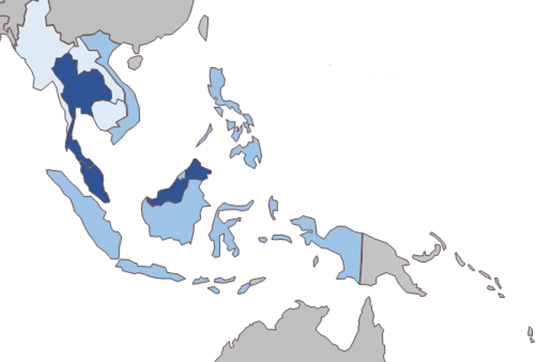In this issue, we provide information on the:
- ASEAN SHINE – Lighting regional market assessment and an update on the broader ASEAN SHINE programme;
- Australian Draft Regulation Impact Statement and Draft MEPS for LED lighting;
- New IEA 4E SSL Annex performance tiers;
- IEA Energy Efficiency Market Report 2016;
- Australian government GEMS lighting check testing results;
- CIE S 025 training workshop;
- Australian report on LED-dimmer compatibility;
- SEAD Global Efficiency Medal lighting competition;
- Singapore Mandatory Energy Label and Minimum Standards for General Purpose Lamps.
ASEAN SHINE – Lighting regional market assessment
|
|
The results of a lighting market assessment undertaken in the ASEAN region by the International Institute for Energy Conservation (IIEC) on behalf of the United Nations Environment Programme (UNEP) are now available in the resources section of the lites.asia website. The ASEAN Regional Efficient Lighting Market Assessment was conducted as part of the ASEAN SHINE – Lighting initiative, which promotes higher efficiency lighting equipment in the ASEAN community through a partnership between the UNEP’s en.lighten initiative and |
ASEAN Centre for Energy, (ACE) with financial support from the European Union’s SWITCH‐Asia programme and the Australian Government.
The assessment is expected to support ASEAN member states in the establishment of harmonized minimum energy performance standards (MEPS) and test standards for lighting products, as well as the implementation of coordinated monitoring, verification and enforcement schemes to ensure compliance with the standards. It considered the current and projected lighting markets in all ASEAN member states and estimated that the total number of lamps installed in the various end‐use sectors in all ASEAN member states in 2014 was around 1.9 billion lamps. The residential sector was the largest end‐use sector in the region, accounting for about 69% of total lamp stock. Compact fluorescent lamps occupy the largest share in the residential lamp stock, accounting for about 48%, followed by linear fluorescent lamps at 34%. Indonesia had the largest share in terms of number of lamps installed in the region, about 547 million lamps.
As part of the assessment, a market forecasting tool, the Policy Analysis Model for ASEAN (PAMA), was developed to project lamp stocks and shipments in each ASEAN member state up to 2030. The model also provides a consumer‐oriented analysis and a national cost‐benefit analysis of lighting policies. The model uses country‐specific data and indices (such as population, GDP, per capita income, electrification and distribution rates) in combination with product‐specific data (lamp shipment by types, efficacies and lifetimes) to estimate impacts from various energy efficiency policy scenarios.
To download a copy of the ASEAN Regional Efficient Lighting Market Assessment, the PAMA stock and shipment model and the associated user guide, click here.
ASEAN SHINE progress to date and plans for the future
The ASEAN Standards Harmonization Initiative for Energy efficiency (ASEAN SHINE) is a United Nations Environment Programme-International Copper Association (UNEP-ICA) initiative implemented under the steering of the ten ASEAN Ministries of Energy. Initiated in 2013, ASEAN SHINE started with a focus on air conditioners with the ambitious objective of market transformation in favor of higher efficiency air conditioners. Since then it has made great contributions towards this goal – testing methods standards have been harmonized, a regional policy roadmap was adopted by the ASEAN Ministers of Energy Meeting (AMEM) in October 2015, followed by the development and adoption of national policy roadmaps in ASEAN in late 2016. These policy roadmaps set goals in terms of increasing Minimum Energy Performance Standards (MEPS) over time and foundations for increasing regional cooperation in promoting energy efficiency and strengthening monitoring, verification and enforcement. ASEAN SHINE has also worked with testing laboratories to build their capacity on international testing standards, and provided support to local air conditioner manufacturers through exposure to best available technology and training on design of higher efficiency heat exchangers. ASEAN SHINE has also embarked on national consumer awareness campaigns through the training of sales persons with a smart phone Application (AC SELECT, available on Google Play and App Store) designed to demonstrate the economic benefits of higher efficiency air conditioners to consumers.
In early 2016, ASEAN SHINE expanded its scope to lighting, with the start of ASEAN SHINE – Lighting, implemented through a partnership between the UNEP’s en.lighten initiative and ASEAN Centre for Energy (ACE), with financial support from the European Union’s SWITCH‐Asia programme and the Australian Government. Following the same methodology adopted for air conditioners, work has started to harmonize ASEAN standards for efficient lighting (with priority on linear fluorescent lamps and non-directional LED) and developing a regional policy roadmap to set long-term aspirational goals in terms of MEPS and market transformation (which will be followed by national policy roadmaps).
Further expansion of ASEAN SHINE is now being planned. As part of this, a two-day event was organized on 29-30 November 2016 in Bangkok, to disseminate the achievements of ASEAN SHINE so far and prepare for its expansion to other equipment, such as refrigerators, distribution transformers and electric motors. A regional stakeholders’ consultation workshop was organized with policymakers to review and adopt policy recommendations that will be used to develop action plans for each technology. The workshop gathered about 40 participants from ASEAN countries, including representatives from ministries of energy and trade. Draft action plans will be reviewed during the first quarter of 2017 by ASEAN ministries of energy, for adoption during the mid-year ASEAN EE&C SSN annual meeting (ASEAN SHINE’s Steering Committee).
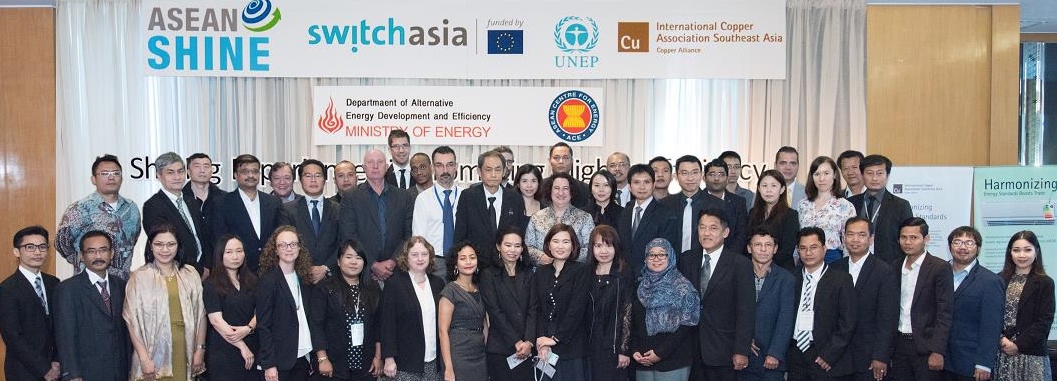
The two-day event was attended by representatives from the APEC Secretariat, UNEP, UNDP, the European Union and the International Energy Agency (Chair of the ASEAN SHINE’s Advisory Committee), and hosted by Thailand’s Department of Alternative Energy Efficiency and Development (DEDE), Ministry of Energy.
It is expected that all reports, materials, and videos will be uploaded on the ASEAN SHINE website in late December 2016.
Australia and New Zealand continue to set the standard for energy efficient lighting
The Equipment Energy Efficiency (E3) Program in Australia and New Zealand has long been one of the pioneers in regulating lighting products and it continues to work with industry to improve the efficiency and quality of lighting solutions in these markets. As part of this ongoing process, the Program has developed a consultation Regulation Impact Statement (RIS) considering policy options to improve the energy efficiency of residential and commercial lighting in Australia and New Zealand.
Although the content of the RIS is specific to the markets in these countries, it provides an interesting model for countries on conducting this kind of analysis and consultation. It may also be of direct relevance to countries with a lighting manufacturing industry, who may wish to submit comments on the RIS.
|
The RIS considers four lighting products currently subject to energy efficiency regulations under the Greenhouse and Energy Minimum Standards Act 2012 (Australia) and New Zealand Energy Efficiency (Energy Using Products) Regulations 2002, including:
Further, it considers two products that are currently not subject to mandatory energy efficiency requirements:
|
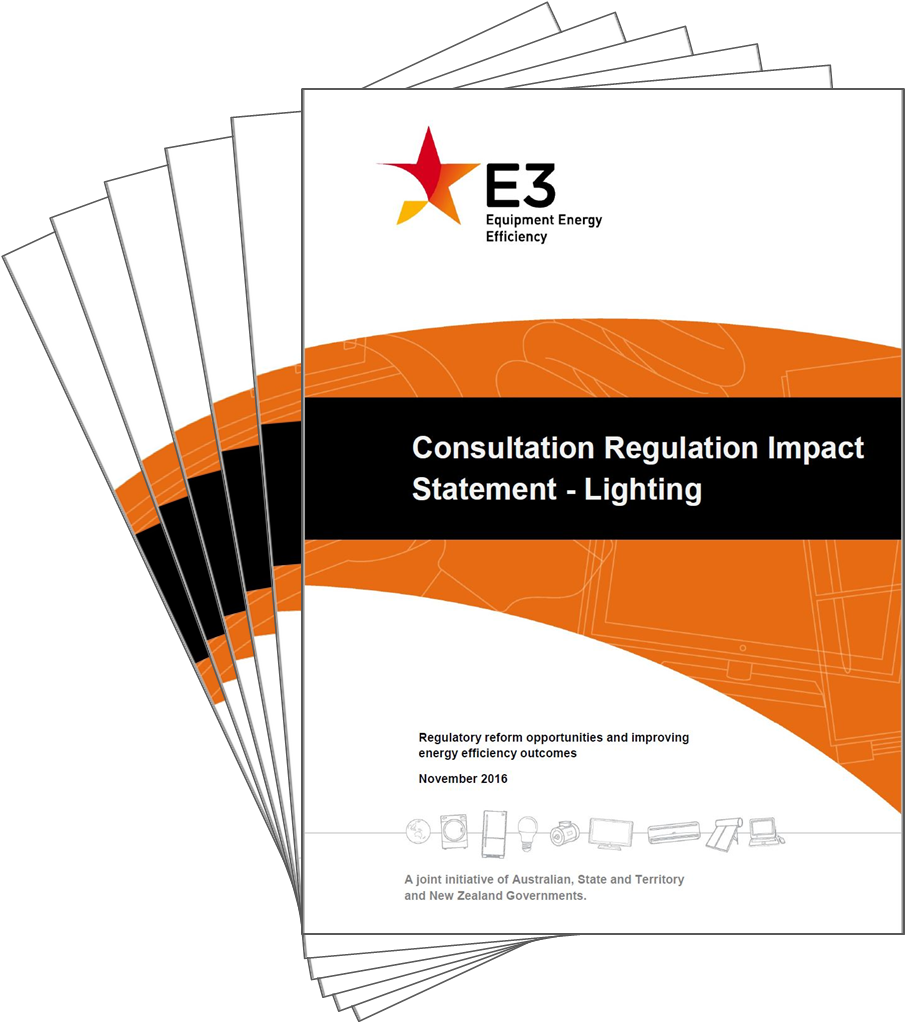 |
While the current regulations have gone some way to achieving their objective by promoting and improving lighting energy efficiency, the report found that there is significant scope to revise or introduce requirements to improve energy efficiency and reduce associated greenhouse gas emissions.
Four key policy options, in various combinations, are outlined in the consultation RIS. These proposals include:
- Introduction of MEPS for LED lamps and integrated luminaires (see following article for more information on the proposed draft MEPS);
- Introduction of MEPS for non-integrated commercial luminaires;
- Increasing incandescent and halogen MEPS (Australia only) to remove the most inefficient lamps;
- Introduction of mandatory labelling for lamp products primarily used in the residential sector.
The current preferred option is to phase out inefficient halogen lighting (Australia only), coupled with minimum energy performance standards for LED lighting and non-integrated commercial luminaires. It is estimated that this option would save the community $2.8 billion to 2030. Implementation would be staged, starting in 2018.
The proposal would require households and businesses to pay a little more upfront for lighting, but more energy efficient, longer-lasting lamps would save money through lower electricity and replacement costs. Some households and businesses with inefficient lighting may be required to upgrade their existing lighting systems in the move to higher energy efficiency.
For further information on the RIS and on the consultation process, or to download a copy of the document, click here to view the consultation pages on the Energy Rating website.
Australia and New Zealand draft MEPS for LED lighting released
As part of the consultation exercise discussed in the previous article, the joint Australia-New Zealand Equipment Energy Efficiency (E3) Program has developed draft minimum energy performance standard (MEPS) for light emitting diode (LED) lighting. This draft MEPS follows on from the range of options for addressing LED lighting efficiency and performance in Australia and New Zealand outlined in the discussion paper, Product Profile: Light Emitting Diodes (LEDs), released in September 2015.
The draft MEPS has been developed in consultation with a technical working group of stakeholders from lighting and control supply, government programs and test laboratories, and was issued for stakeholder comment as part of the development of these proposals. It draws largely upon the IEA 4E SSL Annex performance tiers for the proposed performance levels (see following article). Any application of a MEPS for LED lighting in Australia and New Zealand will be subject to approval by governments following public consultation on the Regulation Impact Statement released in November 2016.
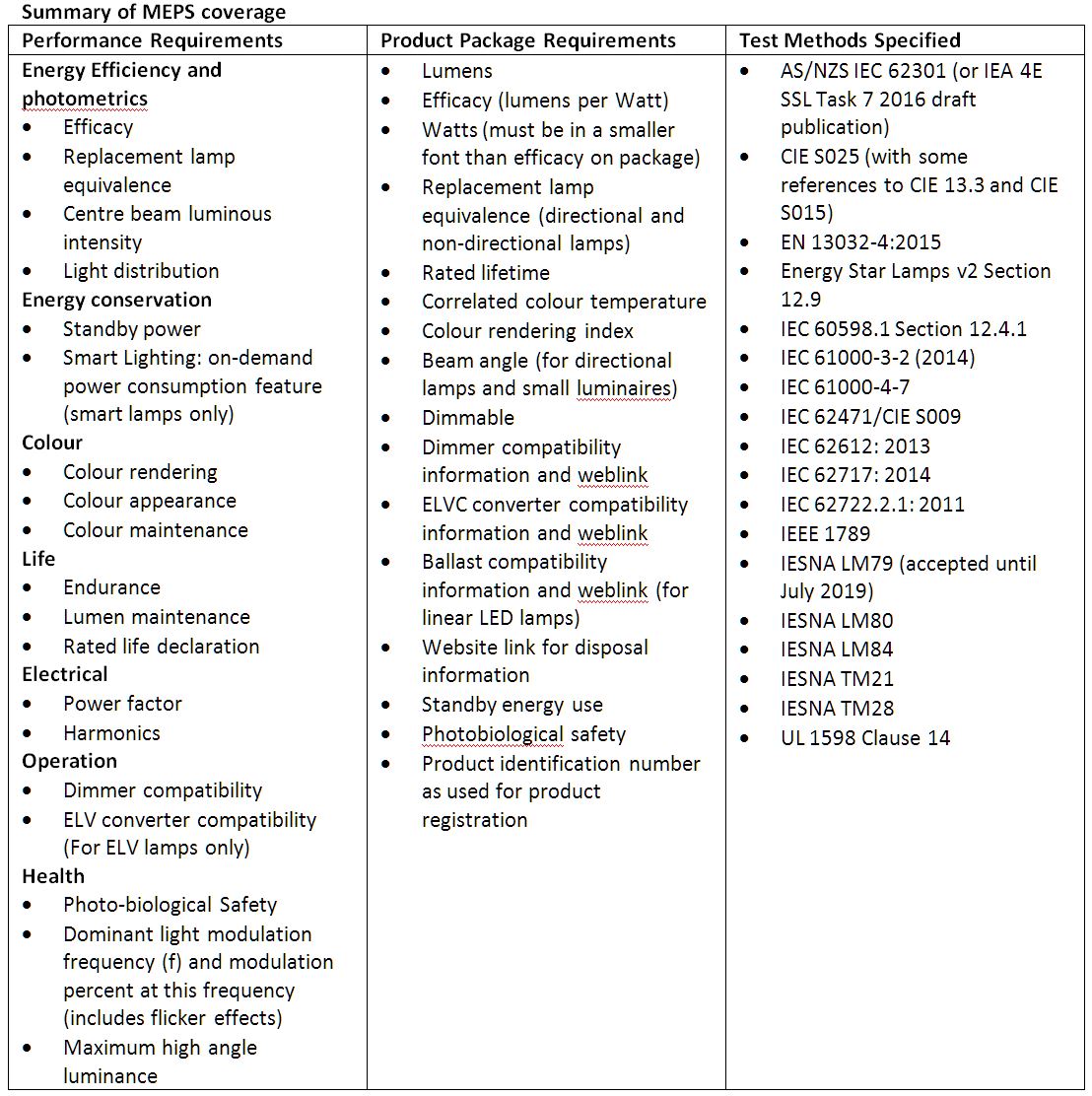 |
The standard would apply to the sale and commercial use of a range of LED products (including lamps, planar, directional and non-directional luminaires) ) and proposes: performance requirements for energy efficiency and photometrics, energy conservation, colour, life, electrical characteristics, operation and health (along with a specification of the test method to be used for each attribute); and product package marking requirements (as outlined in the table opposite, or click here for a larger PDF). Note that not all parameters apply to all LED types, and some only apply where specific claims (e.g. compatibility) are made.
While still in development, this draft MEPS provides a first model of a comprehensive standard addressing the efficiency and performance requirements for LED lighting which may provide a useful tool |
for policymakers, standards personnel and regulators when considering their own MEPS for LED lighting. The draft LED MEPS may be viewed as Attachment H of the consultation Regulation Impact Statement (RIS). To download a copy of this document from the Australian Energy Rating website, click here.
IEA 4E SSL Annex releases new performance tiers for LED lamps and luminaires
In November 2016, the IEA 4E SSL Annex published new and updated “quality and performance tiers” for seven different LED lamps and luminaires:
- Non-directional lamps;
- Directional lamps;
- Downlight luminaires;
- Linear LED lamps replacing fluorescent tubes;
- Outdoor lighting (street lighting);
- High/Low bay LED luminaires;
- Planar luminaires.
These seven documents were developed by the SSL Annex member governments’ experts and have undergone public review. They offer policymakers and programme administrators guidance on which parameters to consider, and the levels that may be appropriate, when specifying or regulating LED products. Parameters include efficacy, lifetime, light colour, durability, and many other metrics.
By providing these recommended quality and performance tiers, it is hoped that governments and programme managers can more quickly develop programme specifications at lower costs and that some harmonisation is brought to the market. For example, the draft Australian and New Zealand MEPS for LED lighting discussed in the article above largely draw upon these performance tiers for the proposed performance levels.
Twenty technical experts from the SSL Annex’s eight member countries: Australia, Denmark, France, Korea, Sweden, United Kingdom, and United States of America and expert member country China have worked together to develop these performance tiers for LED-based lighting – including both lamps and luminaires. Several performance tier levels were set to address the various priorities and needs from each country or region.
This approach is expected to help participating governments to define globally consistent requirements for programmes to promote market adoption of solid state lighting products, as well as being useful for governments planning to adopt national energy policies and regulations covering solid state lighting technologies.
For more information, or to download copies of the performance tier documents, click here to visit the IEA 4E SSL Annex website.
IEA maps progress of energy efficiency
|
The International Energy Agency's Energy Efficiency Market Report 2016 tracks a range of indicators of energy efficiency progress and policy development globally. The report found that energy intensity improvements are speeding up, efficiency is driving down demand for energy, and that currently just 30 per cent of the world's energy consumption is subject to mandatory efficiency policies.
According to the report, energy consumption for lighting witnessed the largest jump in policy coverage. Mandatory standards now cover more than 60% of energy consumption for lighting worldwide, while coverage in the use of space heating and appliances has doubled. ‘Best in class’ efficiency standards for heating, cooling, lighting could lower global residential energy use by 14 per cent. |
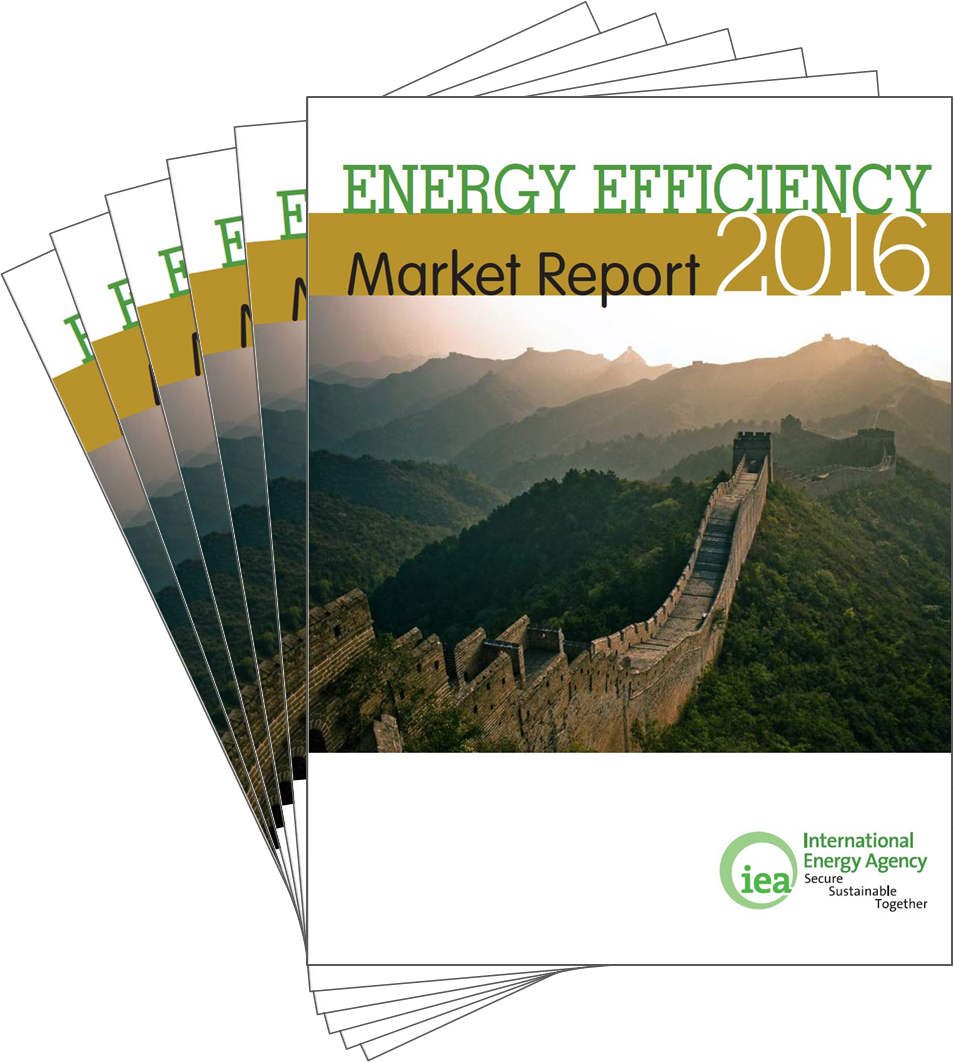 |
The report also includes a special feature on China, which highlights the considerable reductions in energy intensity that have been achieved in recent years.
Click here to download a copy of the full report, or to view the IEA’s snapshot of the key messages from the report on the IEA website, click here.
Australian government compliance testing results for lighting products available
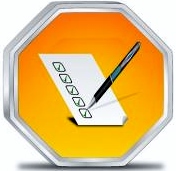 |
The Australian Greenhouse and Energy Minimum Standards (GEMS) Regulator has published a report, GEMS Act Compliance: Check Testing Results January to June 2016, detailing the results of compliance testing carried out in the six months to 30 June 2016. This included 49 lamp models. The testing was undertaken to ensure models of GEMS products meet the relevant performance level requirements, often referred to as minimum energy performance standards or MEPS; and the energy efficiency claims of manufacturers and suppliers. Compliance tests are conducted on |
behalf of the GEMS Regulator by National Association of Testing Authorities (NATA) accredited or affiliated laboratories either in Australia or overseas.
All models of the ballasts for fluorescent lamps and double capped fluorescent lamps tested met the relevant GEMS level requirements and energy efficiency claims of manufacturers and suppliers at the completion of Stage (1) and Stage (2) testing. A number of compact fluorescent lamps failing to meet requirements at the completion of Stage (1) testing were not subject to Stage (2) testing given they were no longer supplied in the market. Three incandescent lamps that failed Stage (1) testing chose to arrange Stage (2) testing that subsequently found those models met the relevant requirements and claims of the manufacturers and suppliers.
To download a copy of the report from the Energy Rating website, click here.
CIE workshop on the application and use of CIE S 025
|
The International Commission on Illumination (CIE) is a technical, scientific and cultural organization which for over 100 years has been devoted to worldwide cooperation and the exchange of information on all matters relating to the science and art of light and lighting, colour and vision, photobiology and image technology. |
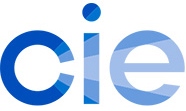 |
With strong technical, scientific and cultural foundations, the CIE is an independent, non-profit organization that serves member countries on a voluntary basis. Since its inception in 1913, the CIE has become a professional organization that represents the best authority on its subject matter and as such is recognized by the ISO as an international standardization body.
In 2015, the CIE published CIE S 025, the first international measurement standard for LED lamps, LED luminaires and LED modules, which provides requirements to perform reproducible and traceable photometric and colorimetric measurements on LED lamps, LED modules, and LED luminaires.
To facilitate an introduction to the application and use of the new standard, CIE Division 2 is organizing a tutorial and practical workshop. The workshop will focus on the implementation of the new international measurement standard in industrial test laboratories and national metrology institutes. In the tutorial, invited experts will present lectures from basic concepts to advanced techniques in photometric and colorimetric measurements, aimed at engineers, testing-laboratory staff and researchers in LED and solid state lighting measurement and other related fields.
The practical workshop will be held in the optics laboratories of the National Metrology Institute of Switzerland (METAS) where state-of-the-art measurement equipment, including several goniophotometers, integrating spheres, spectroradiometers and tuneable lasers, is available for practical demonstration. The participants will learn how to characterize photometric, radiometric, and spectrometric measurement devices and establish measurement uncertainty budgets according to international standards (ISO/IEC Guide 98/3).
The tutorial is timed to coincide with meetings of the CIE Technical Committees and a workshop to discuss the results of two European research projects related to photometry and radiometry, MESaIL and PhotoLED.
For more information on the workshop, or to register, click here to visit the CIE website. Please note that, due to the practical nature of the workshop, the number of places is limited.
Australian report sheds light on LED dimmer issues
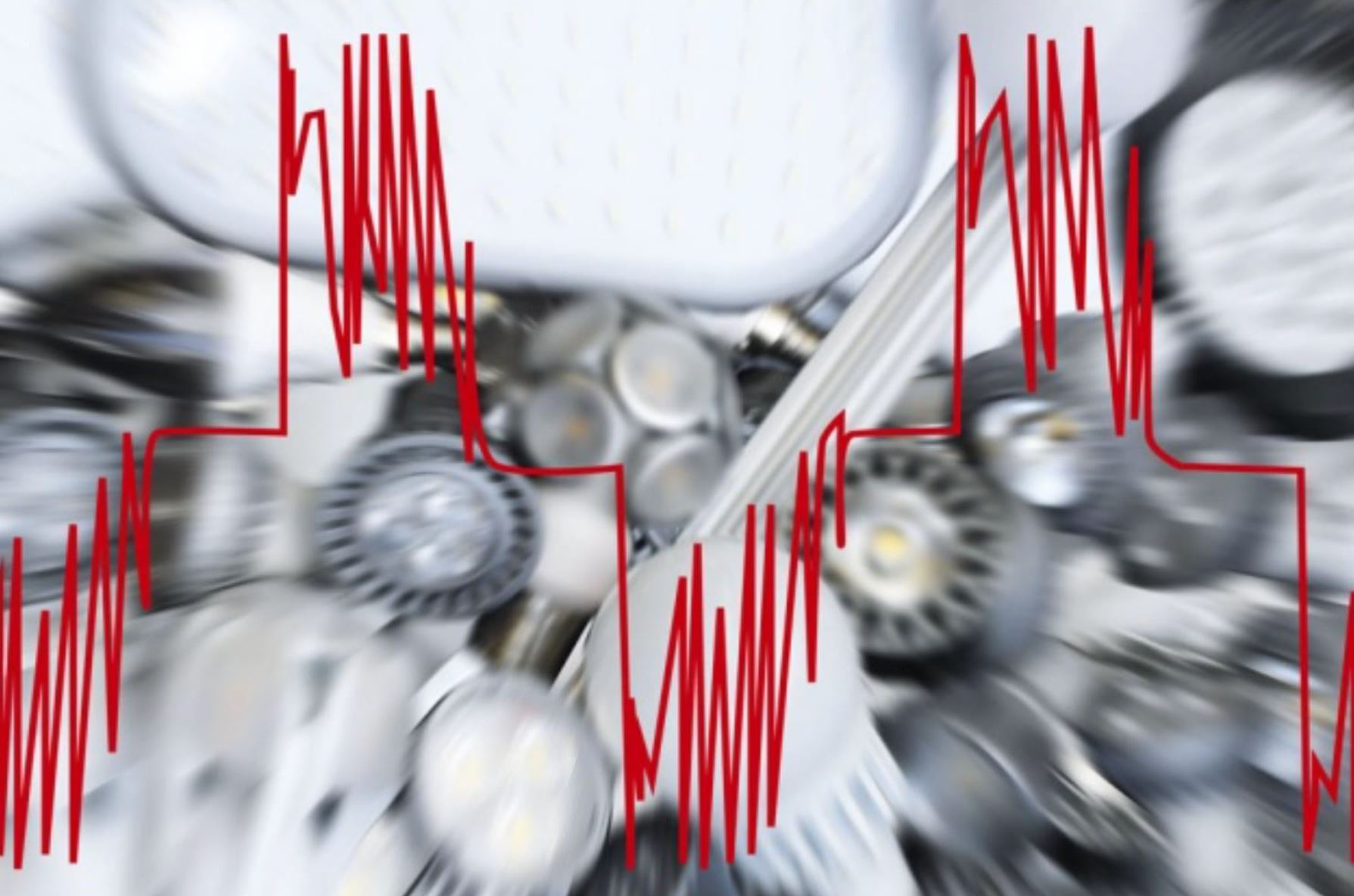 |
A new report, LED Lamp and Dimmer Testing Compatibility, commissioned by the Australian Equipment Energy Efficiency (E3) Program, presents the results of a study to investigate problems that have been reported by consumers when using modern dimmable light emitting diode (LED) lamps with existing lighting controls. These problems include: the product not operating to a satisfactory level of performance, not working at all or flickering when the original incandescent or halogen lamp is replaced with a dimmable LED lamp. |
The Australian National Electrical and Communications Association (NECA), which carried out the study, conducted compatibility testing for the purpose of:
- Identifying the extent of compatibility to inform consumer impacts for use of dimmable LED lamps;
- Compiling the test results to produce a compatibility chart for distribution to electricians, to enable them to assist households in identifying a suitable LED dimmable lamp that will work with their existing dimmer system.
Overall, the results from LED dimmer compatibility testing showed that:
- There are LED dimmable lamps on the market, that matched with a compatible dimmer, perform effectively, with no flicker and full dimming range, meaning that consumers who value the ability to dim their lamps are able to continue to access this product range;
- Leading edge dimmers are generally found to be non-compatible when used with LED omni-directional and directional downlights (ELV and MV);
- Trailing edge dimmers had mixed results working with some LED lamps whilst others flickered, highlighting that care must be taken when selecting and matching dimmer products for compatibility between brands and LED lamp types;
- When an LED light source has been dimmed to a low level, and then switched off, some product configurations did not allow the LED to switch back on until the dimmer has been manually re-set to a range of greater than 50 per cent of the maximum dimmer setting (occurred with both leading and trailing edge dimmers);
- Specifications for dimming performance of LED lamps varies across manufacturers, meaning that a households with different brands of LED lamps connected to the same dimmer, may notice a difference in their light output.
NECA concluded that the combination of existing legacy transformers and dimmers which were designed for high wattage resistive loads, as opposed to digital LED light sources, will continue to pose challenges in some cases when current generation LED lamps are installed.
To download a copy of the report from the Energy Rating website, click here.
SEAD Global Efficiency Medal competition nomination period extended
|
The Super-efficient Equipment and Appliance Deployment (SEAD) Initiative sixth Global Efficiency Medal competition is now open for nominations until 16 January 2017. The competition includes lighting products and will recognise the most energy efficient industrial and outdoor lighting products in two categories (high and low bay luminaires and street lighting luminaires) sold across three regions (Europe, India, and North America). Past competitions followed a |
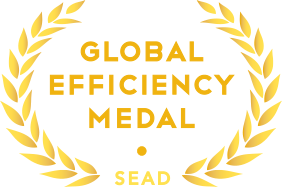 |
winner-take-all approach. However, for this competition, in addition to recognising the winning products, all entrants that meet the competition’s minimum criteria will receive recognition. Winners are expected to be announced and honoured at a global awards ceremony in May or June 2017.
Manufacturers are invited to review the Official Competition Rules and submit their declaration of performance in their chosen category through the links on the Global Efficiency Medal website. Purchasers and purchase influencers are invited to support the competition and to consider purchasing award winning products by signing a Letter of Support.
The competition is also coordinating with the Global Lighting Challenge. Manufacturers, purchasers, and purchase influencers participating in the Global Lighting Challenge and SEAD’s Global Efficiency Medal will be part of a high-profile global platform built to recognise public- and private-sector leaders driving the global transition to efficient lighting and cutting global carbon emissions.
For more information, including the Official Competition Rules and Letter of Support, visit the Global Efficiency Medal Lighting Awards webpage.
Singapore’s Mandatory Energy Label and Minimum Standards for General Purpose Lamps
In July 2015, Singapore introduced a new energy labelling and standards programme for lamps. This follows an earlier household energy consumption survey, conducted by the National Environment Agency (NEA), which found lighting to be among the top five energy-consuming household appliances and devices.
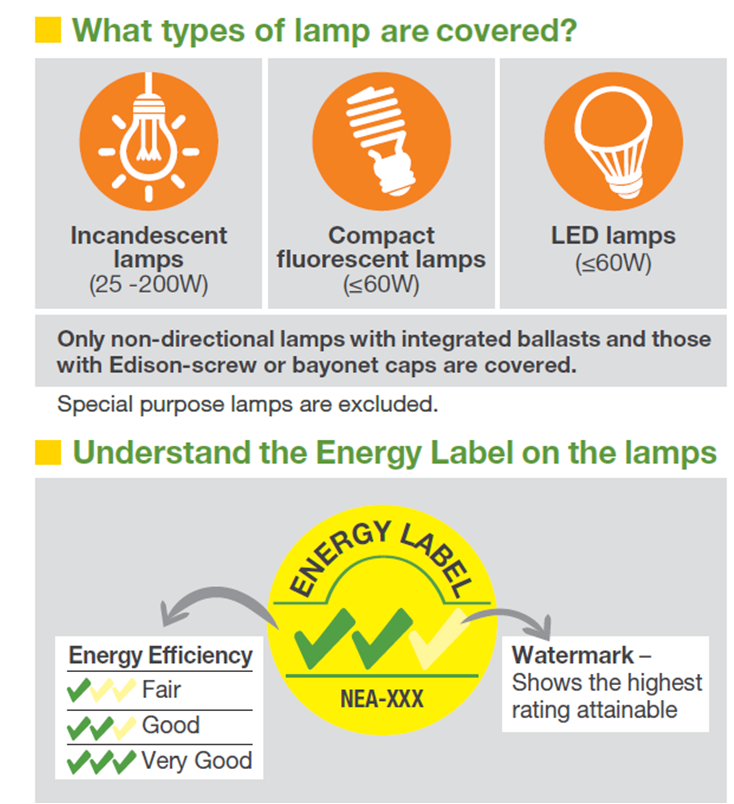 |
The following types of lamps, which are commonly used in homes, must meet Minimum Energy Performance Standards (MEPS) and comply with Mandatory Energy Labelling (MELS) requirements:
The energy rating system for lamps has three efficiency bands. The highest efficiency band is denoted by three ticks and the lowest by a single tick. Incandescent lamps, CFLi and LED lamps must also comply with MEPS. Incandescent lamps must be of at least one-tick efficiency, while CFLi and LED lamps must be of at least two-tick efficiency. |
In addition to lamp efficiency, the MEPS also puts in place requirements for lumen maintenance for the LED and CFL products. These measures help consumers select more efficient lamps and have resulted in the removal of the least efficient ones from the market. In doing so, consumers will not be locked into the high energy and life cycle costs of inefficient lamps. This is part of the National Environment Agency’s (NEA) continual effort to help households become more energy efficient and contribute to Singapore’s Climate Action Plan to reduce carbon emissions.
For more details on MELS and MEPS for lamps on the NEA website, click here.
Dates for your diary
CIE Tutorial and Practical Workshop
LED Lamp and Luminaire Testing to CIE S 025
8-11 May 2017 – METAS Bern-Wabern, Switzerland
International Energy Program Evaluation Conference
1-2 November 2017 – Bangkok, Thailand

